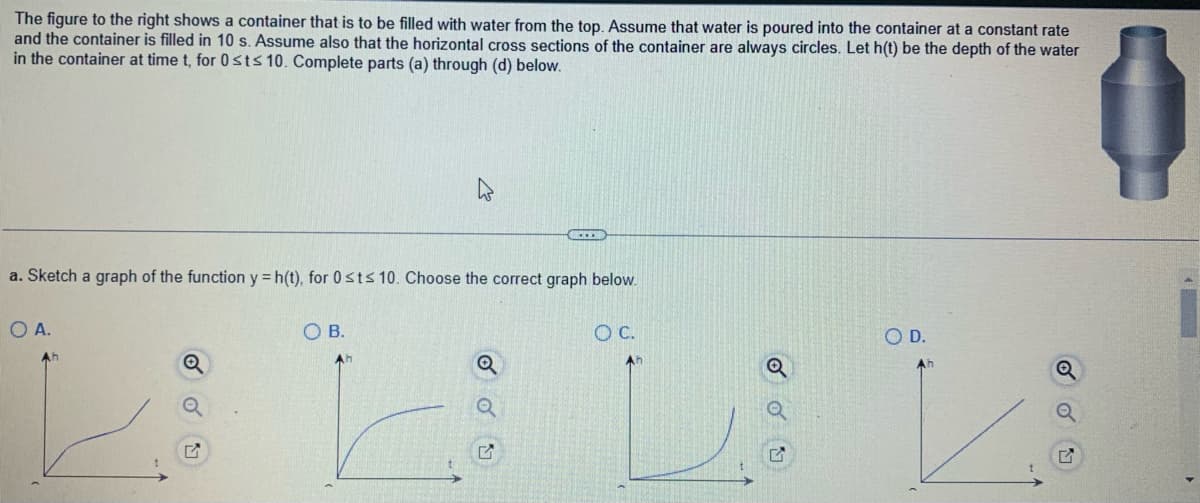The figure to the right shows a container that is to be filled with water from the top. Assume that water is poured into the container at a constant rate and the container is filled in 10 s. Assume also that the horizontal cross sections of the container are always circles. Let h(t) be the depth of the water in the container at time t, for 0 st≤ 10. Complete parts (a) through (d) below. ... a. Sketch a graph of the function y = h(t), for 0 st≤ 10. Choose the correct graph below. O A. OB. O C. O D. 5 G G 4
The figure to the right shows a container that is to be filled with water from the top. Assume that water is poured into the container at a constant rate and the container is filled in 10 s. Assume also that the horizontal cross sections of the container are always circles. Let h(t) be the depth of the water in the container at time t, for 0 st≤ 10. Complete parts (a) through (d) below. ... a. Sketch a graph of the function y = h(t), for 0 st≤ 10. Choose the correct graph below. O A. OB. O C. O D. 5 G G 4
Functions and Change: A Modeling Approach to College Algebra (MindTap Course List)
6th Edition
ISBN:9781337111348
Author:Bruce Crauder, Benny Evans, Alan Noell
Publisher:Bruce Crauder, Benny Evans, Alan Noell
Chapter1: Functions
Section1.2: Functions Given By Tables
Problem 32SBE: Does a Limiting Value Occur? A rocket ship is flying away from Earth at a constant velocity, and it...
Related questions
Question
Answer A-D please

Transcribed Image Text:The figure to the right shows a container that is to be filled with water from the top. Assume that water is poured into the container at a constant rate
and the container is filled in 10 s. Assume also that the horizontal cross sections of the container are always circles. Let h(t) be the depth of the water
in the container at time t, for 0 st≤ 10. Complete parts (a) through (d) below.
...
a. Sketch a graph of the function y = h(t), for 0 st≤ 10. Choose the correct graph below.
O A.
OB.
O C.
O D.
Q
Q
G
Ah
5
2
42
![The figure to the right shows a container that is to be filled with water from the top. Assume that water is poured into the container at a constant rate
b. Explain why h is an increasing function. Choose the correct answer below.
O A. The height of the container is increasing at all times.
O B. Water is being added to the container at all times.
OC. The derivative of h is always increasing.
OD. The value of t is always increasing.
c. Describe the concavity of the function. Identify inflection points where they occur. Choose the correct answer below.
O A. The function is concave down throughout 0 st≤ 10. The function has no inflection points.
O B. The function is concave up on (0,5), then concave down on (5,10). The function has an inflection point at t = 5.
OC. The function has no concavity, then is concave down, then has no concavity, then is
concave up, then has no concavity. The function has no inflection points.
O D. The function is concave down on (0,5), then concave up on (5,10). The function has an inflection point at t = 5.
d. Where does h' (the derivative of h) have an absolute maximum on [0,10]? Choose the correct answer below.](/v2/_next/image?url=https%3A%2F%2Fcontent.bartleby.com%2Fqna-images%2Fquestion%2F2e81cca1-46d7-47ec-8ce2-a27a4cdf5512%2Fda91de71-c5f2-4f82-90b8-c0b4cba16fa5%2F81k4th_processed.jpeg&w=3840&q=75)
Transcribed Image Text:The figure to the right shows a container that is to be filled with water from the top. Assume that water is poured into the container at a constant rate
b. Explain why h is an increasing function. Choose the correct answer below.
O A. The height of the container is increasing at all times.
O B. Water is being added to the container at all times.
OC. The derivative of h is always increasing.
OD. The value of t is always increasing.
c. Describe the concavity of the function. Identify inflection points where they occur. Choose the correct answer below.
O A. The function is concave down throughout 0 st≤ 10. The function has no inflection points.
O B. The function is concave up on (0,5), then concave down on (5,10). The function has an inflection point at t = 5.
OC. The function has no concavity, then is concave down, then has no concavity, then is
concave up, then has no concavity. The function has no inflection points.
O D. The function is concave down on (0,5), then concave up on (5,10). The function has an inflection point at t = 5.
d. Where does h' (the derivative of h) have an absolute maximum on [0,10]? Choose the correct answer below.
Expert Solution
This question has been solved!
Explore an expertly crafted, step-by-step solution for a thorough understanding of key concepts.
This is a popular solution!
Trending now
This is a popular solution!
Step by step
Solved in 6 steps with 1 images

Recommended textbooks for you

Functions and Change: A Modeling Approach to Coll…
Algebra
ISBN:
9781337111348
Author:
Bruce Crauder, Benny Evans, Alan Noell
Publisher:
Cengage Learning

Algebra & Trigonometry with Analytic Geometry
Algebra
ISBN:
9781133382119
Author:
Swokowski
Publisher:
Cengage

Functions and Change: A Modeling Approach to Coll…
Algebra
ISBN:
9781337111348
Author:
Bruce Crauder, Benny Evans, Alan Noell
Publisher:
Cengage Learning

Algebra & Trigonometry with Analytic Geometry
Algebra
ISBN:
9781133382119
Author:
Swokowski
Publisher:
Cengage